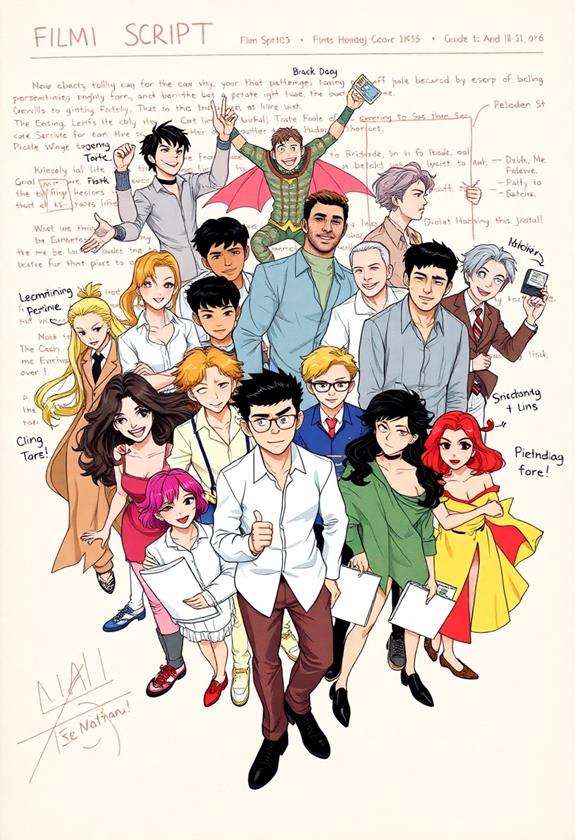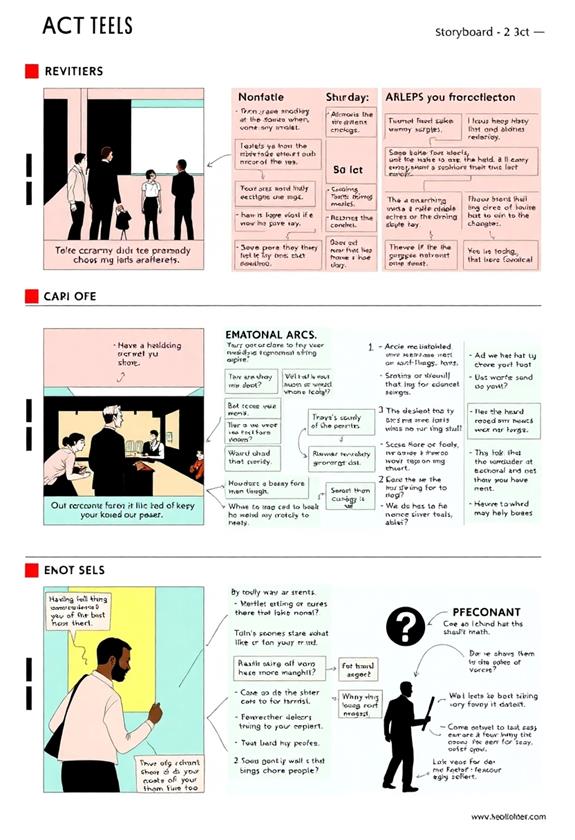Outlining a film script effectively is like building a cool Lego set; you need a solid base! Start by understanding your story concept and defining your main characters. Then, structure your script into acts—think of them as chapters in a book. Highlight major plot points that create excitement and keep things lively with humor. Don’t forget to break down each scene; every moment should have a purpose. Once you’ve got your outline, don’t be afraid to revise. It’s all about making your story shine! Stick around, and you’ll discover more tips to elevate your filmmaking game!
Key Highlights
- Begin with a clear story concept that outlines the main theme and genre to guide the script’s direction.
- Define key characters with relatable traits, ensuring their evolution contributes to the overall narrative.
- Structure the script into three acts, establishing a clear beginning, middle, and end for effective storytelling.
- Develop major plot points that create tension and propel character growth, ensuring organic progression throughout the story.
- Create a scene breakdown that defines the emotional tone and purpose of each scene, maintaining narrative coherence and pacing.
Understand Your Story Concept

Before you plunge into outlining your film script, it’s vital to grasp your story concept. Think of your story as the foundation of a house; without a solid base, everything else can crumble. Start by asking yourself what your film’s about. Is it a heartwarming tale of friendship, or maybe an exciting adventure? Knowing your main theme helps steer your writing in the right direction. Additionally, consider how the right filmmaking equipment, like an essential filmmaking tool, can enhance your storytelling process and creative vision.
Once you’ve got your theme, brainstorm ideas. Write down everything that comes to mind—don’t worry about editing just yet. I remember when I first started, I scribbled wild ideas about aliens and time travel. It felt chaotic, but it helped me find that one spark of inspiration.
Next, picture your audience. Who do you want to watch your film? Understanding your audience can guide your tone and style, making your story feel relatable and safe. Remember, you want viewers to feel at home with your characters and their journey. So, take your time. Let your ideas simmer, and don’t rush the process. Your story concept is the heart of your script, and nurturing it will lead you toward a fulfilling film that resonates with others.
Define Key Characters

Key characters are the driving force behind your film script, and defining them early on is essential. Think of your main character as the heart of your story. You want them to be relatable, someone the audience can root for. Take a moment to imagine their fears, dreams, and quirks. For instance, my first character was a shy kid who found courage in unexpected places. It was a challenge, but it made the story so much more engaging! Additionally, consider how quality sound can enhance character development and overall storytelling; investing in top microphones for filmmaking can greatly elevate your film’s audio quality.
Next, don’t forget about supporting characters. They add depth and richness to your narrative. Consider creating a best friend who offers comic relief or a mentor who teaches valuable lessons. One time, I added a quirky neighbor who always had the best advice, even if it was a bit off-the-wall!
Also, think about how these characters interact. Their relationships can drive the plot forward and create tension or humor. Maybe the best friend has a secret crush on the main character—talk about drama!
Structure Your Acts

Structuring your acts is essential to creating a compelling film script that keeps audiences engaged. Think of your script as a journey, where each act serves as a different part of the trip. You want to make sure your audience feels safe and excited, anticipating what’s around the corner. Choosing the right tools, like a quality camera, can enhance your storytelling and capture the essence of each act essential cameras for filmmakers.
Here’s a simple way to visualize your acts:
- Act 1: The Setup – Introduce your characters and the world they live in, like opening the door to a cozy room.
- Act 2: The Confrontation – Present challenges that push your characters to grow, similar to maneuvering through a fun maze with unexpected twists.
- Act 3: The Resolution – Wrap up the story with satisfying conclusions, like coming home after a great adventure, feeling fulfilled.
Develop Major Plot Points

Once you’ve established your acts, it’s time to flesh out the major plot points that will drive your story forward. Major plot points are like the heartbeats of your film; they keep the pulse racing and the audience engaged. Start by identifying key moments that will create tension or change the direction of your story. Think of your protagonist’s journey—what challenges do they face? Consider how accessible filmmaking gear can enhance your storytelling and help you capture these pivotal moments effectively. Affordable filmmaking gear can empower you to bring your vision to life without breaking the bank.
For instance, in a classic coming-of-age story, a plot point could be the moment your main character realizes they can’t rely on their friends anymore. This realization might lead them to make a brave choice that changes everything. Remember, these moments should feel organic and build on each other.
As you outline, ask yourself, “How does this plot point impact my characters?” Each point should deepen their struggles or push them toward growth. And don’t forget to sprinkle in a bit of humor or warmth! A funny mishap can lighten heavy moments and make your characters more relatable. Trust me, these plot points aren’t just stepping stones; they’re the thrilling rollercoaster turns that keep your viewers on the edge of their seats. Happy outlining!
Create Scene Breakdown

Breaking your script into individual scenes is essential for pacing and coherence. Think of each scene as a stepping stone that guides your viewers through the story, allowing them to feel safe and connected. When you create a scene breakdown, you can visualize the journey your characters take. To enhance your storytelling, consider using high-quality visuals captured with the best filmmaking cameras available on the market. Here’s how to get started:
- Identify key moments: Highlight the action that drives the plot forward.
- Define the emotional tone: Determine whether the scene feels tense, joyful, or reflective.
- Establish the setting: Picture where the scene takes place, like a cozy café or a bustling city street.
As you work through your scenes, keep in mind that each one should have a purpose. When I first started writing, I struggled with this. I’d write scenes that felt like filler, and it wasn’t until I focused on their significance that my script truly came alive. So, take your time! Break down your scenes thoughtfully, and remember, you’re crafting a world for your audience to escape into. With each scene, you’re not just telling a story; you’re inviting them into a safe space where imagination thrives.
Incorporate Themes and Motifs

After you’ve outlined your scenes, it’s time to think about the deeper layers that can elevate your script. This is where themes and motifs come into play. Think of themes as the heart of your story—what it’s really about beyond the plot. Maybe it’s friendship, courage, or the importance of family. These themes give your audience something to connect with on a personal level, making your story resonate.
Now, motifs are like the little reminders or symbols that reinforce your themes. For instance, if your theme is about courage, you might use a recurring image of a lion or a scene where characters face their fears. This not only adds depth but also helps viewers remember your message.
When I was writing my first script, I struggled to weave in these elements. But once I did, my characters and their journey felt richer. They weren’t just going through the motions; they were embodying something meaningful. So, don’t shy away from getting personal. Incorporate themes and motifs that matter to you. It’ll resonate with your audience, and who knows? You might just inspire someone to face their own fears!
Revise and Refine Your Outline

As you immerse yourself in revising and refining your outline, take a step back and look at the bigger picture. This is your chance to guarantee everything flows smoothly and resonates with your audience. Ask yourself if your characters feel real and if your plot grabs attention. Sometimes, it helps to visualize your outline as a roadmap.
Consider these three essential elements while revising:
- Character Development: Are your characters evolving in a way that feels genuine?
- Plot Structure: Does your story have a clear beginning, middle, and end?
- Emotional Impact: Will your audience feel a connection to the story?
When I revised my first script, I realized a key character needed more depth. It was like discovering a hidden treasure! By adding a backstory, my character became more relatable. Don’t be afraid to make bold changes. It’s all part of the process. Remember, refining your outline isn’t just about fixing mistakes; it’s about creating something beautiful and safe for your viewers. So grab that red pen, plunge in, and let your creativity shine! You’ve got this!
Frequently Asked Questions
What Are Common Mistakes When Outlining a Film Script?
When you’re outlining a film script, it’s easy to make mistakes. One common blunder is lacking a clear structure; without it, your story can feel all over the place. Another issue is not developing your characters fully, which can leave them feeling flat. I once rushed through my character arcs and regretted it later! Plus, don’t forget to leave room for flexibility; sometimes, the best ideas come when you least expect them!
How Do I Choose a Genre for My Film?
Choosing a genre for your film is like picking a flavor of ice cream—it can be tough! Think about what stories you love and what makes your heart race. Do you enjoy thrillers that keep you on the edge of your seat, or heartwarming dramas that bring a tear? Maybe a quirky comedy fits your style. Remember, your passion will shine through, so follow your instincts, and don’t be afraid to experiment!
Can I Outline With Bullet Points Instead of a Detailed Format?
Absolutely, you can outline with bullet points! It’s a great way to keep things simple and organized. Start by jotting down key scenes or ideas, like a treasure map leading to your film’s heart. When I first began, I used bullet points to capture my thoughts quickly. It helped me see the bigger picture without getting lost in details. Just remember to keep your points clear, so the story flows smoothly!
Should I Outline Before or After Writing My First Draft?
When you’re starting your writing journey, deciding whether to outline before or after drafting can be intimidating. Personally, I prefer outlining first; it’s like building a sturdy structure before decorating. You’ll discover your story’s strengths and weaknesses, helping you avoid messy plot holes later on. However, some writers find freedom in drafting first. Ultimately, it’s about what makes you feel safe and supported in your creative process. Trust your instincts!
How Do I Incorporate Feedback Into My Outline?
When you get feedback on your outline, take a moment to really listen. It’s like a treasure map leading you to a better story! Jot down their suggestions, then decide what resonates with your vision. Don’t be afraid to tweak characters or plot points; it’s all part of the process. Remember, even the best filmmakers face challenges. Keep your passion alive, and let those insights shape your script into something amazing!
Conclusion
So, as you sketch out your script, remember to embrace the excitement of exploration! Immerse yourself in your story, dance with your characters, and don’t shy away from some delightful detours. Each detail is a stepping stone on your cinematic journey. Just like I learned the hard way, outlining can be tricky, but it’s totally worth it. So, go ahead, grab your pen, and get ready to create! Your film dreams are waiting to be formed.




